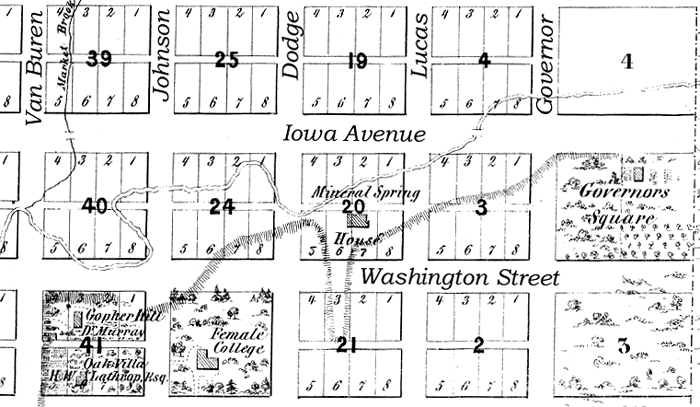
A
section of a 150-year-old map focusing on east-central Iowa City displays
historic plans for a governor’s mansion and women’s college which have
disappeared from today’s reality.
Iowa
City was created as Iowa’s territorial and eventual state capital, complete
with design of its public areas reflecting the layout of Washington DC. The
capital landed, was incubated for 18 years, but flew off to Des Moines in
1857, leaving Iowa City a university in its place.
Although
many believe the private Woodlawn enclave at the east end of Iowa Avenue was
the intended site of the governor’s mansion, it actually was to have been on
the bluff fronting the south face of Iowa Avenue bounded on the west by an
appropriately named Governor Street. The site is labeled “Governor’s
Square” on the 1854 map.
Researched
and drawn by J.H. Millar of Panora near Des Moines, the map covers the entire
city and is surrounded by a dozen drawings of local structures by pioneer Iowa
City artist George Yewell. His “long neck” sketch of Old Capitol on the
map suggests how long final design of its belfry, copula and dome was left
unsettled.
Originally
printed for Iowa City’s first banking and real estate agency, Cook Sargent
& Downey, to promote local growth, many framed reproductions now hang in
local homes and businesses.
“Female
College” labeling on what today is College Green park reflects a historic
gift by the city council of half the park to a joint venture of First Baptist
Church and Odd Fellows Lodge with profits going to prime mover and the
church’s pastor, Rev. Russell Belden, and to Sarah Allen, perhaps a family
member.
Like
four other institutions of higher learning organized in Iowa City during early
years, the college died without bearing fruit. For this enterprise Belden
raised $6,000 in subscriptions during 1853, promising to erect a three-story
30-by-80-foot brick building trimmed with stone.
By
fall 1855 when construction included basement and partial main level, Belden
was stricken with cholera and died a few hours later. The project languished
and eventual demolition cleared the site for the city.
College
Green history also includes a 1908 letter to the Old Settlers Association from
Mrs. Henry Murray describing childhood memory of it as “a wild strawberry
patch and rattlesnake den.”
Mrs.
Murray and her husband, the first permanent local physician, lived nearby at a
home they named Gopher Hill. Now addressed 511 E. Washington, the subsequent
still-existing house there was the life-long home to sisters Mildred and Ruth
Wilslef.
Murray
supervised construction of the first Washington Street bridge of Ralston Creek
in 1847 which cost $30, was active during the 1850s with the first local
public high school, and risk his life treating numerous patients during the
1855 cholera epidemic.
Murray
neighbors were the Henry Lathrup family in what the map labels “Oak
Villa,” a site now addressed 516 College St. next door east of the McGovern
Funeral Home building which until recently served Henry Louis photo.
Lathrup,
a renowned apple grower, edited the local Republican newspaper (1850s), was
county superintendent of schools, served on the city council (1859), as UI
treasurer and on its Board of Regents.
Mineral
Springs House labeling refers to a public bath which an 1883 history reports
was established “by a man named Bastardes” on a spot “over which seems
now to be (where) the chalybeate and sulphur (sic) springs ran together.” It
reports the site once belonged to Iowa Territorial Gov. Robert Lucas who
“did nothing to utilize it.”
Market
Brook labeling refers to a water course which now runs in an underground tube,
having disappeared just like many other dominant features of early Iowa City.
Next
Saturday: Old Hutchinson’s Quarry
at the Art Building addition.
Bob
Hibbs collects local postcards and researches history related to them.
|